Pierre-Narcisse Guérin stands as a significant, if sometimes overlooked, figure in the complex tapestry of French art during the late 18th and early 19th centuries. Born in Paris on May 13, 1774, and passing away in Rome on July 6, 1833, Guérin's career spanned a period of immense political and artistic upheaval. He navigated the waning dominance of Neoclassicism, the style championed by Jacques-Louis David, and played a crucial role, particularly as an educator, in fostering the nascent Romantic movement. His own works, while rooted in Neoclassical principles, often displayed a theatricality and emotional sensitivity that prefigured the concerns of the next generation.
Early Life and Artistic Formation
Born into a Paris still reverberating with the intellectual fervor that would soon ignite the French Revolution, Pierre-Narcisse Guérin's early artistic inclinations led him to the studio of Jean-Baptiste Regnault. Regnault, himself a respected academic painter and a rival to the more politically engaged Jacques-Louis David, provided Guérin with a solid foundation in the Neoclassical tradition. This tradition emphasized clarity of form, idealized human figures, noble subjects drawn from classical history and mythology, and a strong moral underpinning.
Regnault's style, while Neoclassical, often possessed a softer, more sensuous quality than David's stern republicanism, and this nuance may have influenced Guérin's later development. Under Regnault's tutelage, Guérin honed his skills in drawing, composition, and the depiction of the human form, essential prerequisites for success in the highly competitive Parisian art world. The ultimate aspiration for any ambitious young artist was the Prix de Rome, a prestigious scholarship awarded by the Académie Royale de Peinture et de Sculpture (later the Académie des Beaux-Arts).
The Pursuit and Attainment of the Prix de Rome
The Prix de Rome was more than just an award; it was a gateway to advanced study in Italy, the cradle of classical antiquity and Renaissance mastery. Winners were granted a period of residence at the French Academy in Rome, allowing them to immerse themselves in the art of Michelangelo, Raphael, and the ancient sculptors. Guérin first competed for this coveted prize in 1796, securing a commendable third place. This initial success undoubtedly spurred him on.
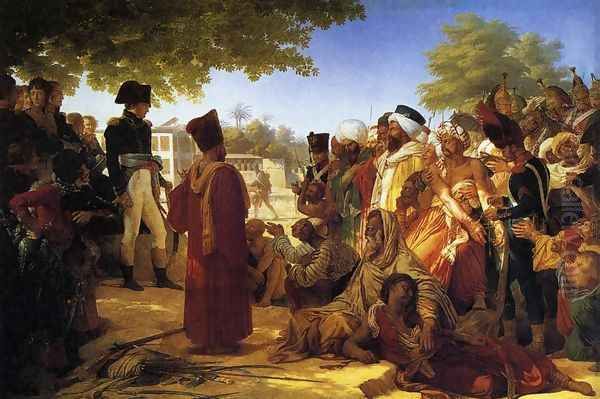
In 1797, Guérin achieved his goal, winning the Prix de Rome. The specific work that won him the prize would have been a prescribed historical or mythological subject, executed according to the rigorous academic standards of the competition. This victory was a pivotal moment, validating his talent and opening the door to Italy. However, due to the political instability and French military campaigns in Italy at the time, his departure was delayed. He would eventually make his way to Rome around 1800, where he furthered his studies, reportedly under Joseph-Benoît Vien, a doyen of Neoclassicism and former director of the French Academy in Rome. The Italian experience was formative, deepening his understanding of classical art and refining his technical abilities.
The Return of Marcus Sextus and Salon Stardom
Before his extended stay in Rome, Guérin achieved a resounding public success with his painting The Return of Marcus Sextus, exhibited at the Paris Salon of 1799. The Salon was the most important public art exhibition in Europe, and a triumph there could make an artist's career. The Return of Marcus Sextus did precisely that for Guérin. The painting depicts a Roman proscribed by Sulla, returning from exile to find his wife dead and his house in mourning.
The work struck a powerful chord with the Parisian public. Its themes of loss, suffering, and the devastating impact of political turmoil resonated deeply in a society still grappling with the aftermath of the French Revolution and the Reign of Terror. The dramatic composition, the poignant grief of Marcus Sextus, and the somber atmosphere captured the zeitgeist. Artistically, the painting demonstrated Guérin's mastery of Neoclassical principles – clear narrative, strong figural drawing, and a balanced composition – but infused with a heightened emotional intensity and a theatrical staging that captivated viewers. This work established Guérin as a leading painter of his generation and brought him significant acclaim.
Mature Career and Notable Works
Following the triumph of Marcus Sextus, Guérin continued to produce significant works, often drawing on classical mythology and history, but also engaging with contemporary events when commissioned. His style, while always anchored in Neoclassical drawing and composition, increasingly embraced a more dramatic and emotionally charged presentation.
One of his notable mythological paintings is Phaedra and Hippolytus (1802). Based on Euripides' tragedy, the painting depicts the moment Phaedra, consumed by an illicit passion for her stepson Hippolytus, is confronted by her horrified nurse. Guérin captures the intense psychological drama, with Phaedra's despair and Hippolytus's shock conveyed through expressive gestures and facial expressions. The rich colors and dynamic composition add to the scene's theatrical power.
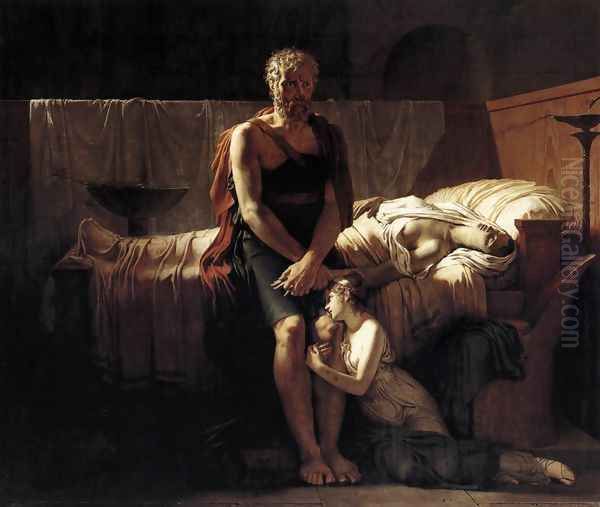
Another significant work is Andromache and Pyrrhus (1810). This painting illustrates a scene from Racine's tragedy Andromaque, itself based on classical sources. Andromache, the widow of Hector, pleads with Pyrrhus, son of Achilles, to spare her son Astyanax. The painting is a complex interplay of emotions: Andromache's desperate maternal love, Pyrrhus's internal conflict, and Hermione's jealous rage. Guérin's skill in rendering these varied emotions and creating a visually compelling narrative is evident.
Guérin also tackled subjects from Roman history, such as Aeneas Relating to Dido the Misfortunes of the City of Troy (1815). This painting, considered one of his finest, depicts the Trojan hero Aeneas recounting the fall of Troy to the Carthaginian queen Dido. The scene is imbued with a sense of pathos and grandeur, with Dido's empathetic listening and Aeneas's sorrowful narration. The rich textures, subtle lighting, and carefully arranged figures showcase Guérin's mature style.
During the Napoleonic era, Guérin, like many artists, received official commissions. His painting Napoleon Pardoning the Rebels at Cairo (1808) depicts an episode from Napoleon's Egyptian campaign. While serving as a piece of imperial propaganda, showcasing Napoleon's clemency, the work also demonstrates Guérin's ability to handle large-scale historical compositions with numerous figures and intricate details. His portrayal of Napoleon is suitably heroic, yet the focus remains on the human drama of the scene. Other artists of the period, such as Antoine-Jean Gros and François Gérard, also excelled in these grand Napoleonic narratives.
Guérin the Educator: Shaping the Next Generation
Perhaps one of Guérin's most enduring legacies lies in his role as an influential teacher. He opened a studio in Paris that attracted a host of talented young artists, many of whom would become leading figures of the Romantic movement. His teaching methods, while grounded in academic tradition, seem to have allowed for a degree of individual expression that was crucial for the development of these burgeoning Romantics.
Guérin emphasized the importance of the sketch (esquisse) as a vital part of the creative process, encouraging spontaneity and the rapid capture of ideas. He also stressed the importance of anatomical study for accurate figural representation, a cornerstone of academic training. It is reported that he even guided students in anatomical dissections to deepen their understanding of the human body.
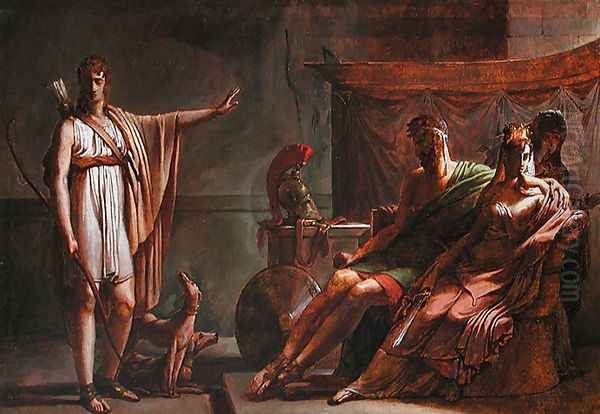
His most famous pupils were undoubtedly Eugène Delacroix and Théodore Géricault. Géricault joined Guérin's studio around 1810. While Géricault was fiercely independent and largely self-taught in many respects, his time with Guérin provided him with essential academic discipline. Géricault's early works show a Neoclassical structure, which he would later infuse with a dynamic energy and realism that defined his Romantic masterpieces like The Raft of the Medusa.
Eugène Delacroix, who would become the standard-bearer of French Romanticism, entered Guérin's studio in 1815. Delacroix found in Guérin a supportive, if traditional, mentor. While Delacroix's passionate temperament, love of vibrant color, and dramatic subject matter would eventually lead him far from Guérin's more restrained Neoclassicism, the foundational skills he acquired in Guérin's atelier were invaluable. Delacroix himself acknowledged Guérin's kindness and the liberal atmosphere of his studio.
Other notable artists who passed through Guérin's studio include Paul Delaroche, known for his meticulously rendered historical scenes that often bordered on melodrama, and Ary Scheffer, another painter who navigated the space between Neoclassicism and Romanticism. The presence of such diverse talents in his studio speaks to Guérin's ability to nurture, rather than stifle, individual artistic voices, even if those voices ultimately diverged from his own path.
Director of the French Academy in Rome
Guérin's standing in the French art establishment was further solidified when, in 1822, he was appointed Director of the French Academy in Rome. This prestigious position placed him at the head of the institution where he himself had been a student. As Director, he was responsible for overseeing the studies of the Prix de Rome laureates, guiding their artistic development, and managing the Academy's affairs.
His tenure as Director, which lasted until 1828, was generally well-regarded. He brought his characteristic diligence and commitment to the role. Living in Rome once again, surrounded by the masterpieces of antiquity and the Renaissance, must have been congenial to his artistic temperament. In 1829, his contributions to French art were recognized when he was made a Baron by King Charles X, a significant honor.
Later Years, Health, and Legacy
Despite his successes and honors, Guérin's later years were marked by declining health. This inevitably impacted his artistic output. He reportedly struggled to complete ambitious projects, such as a planned painting of Pyrrhus and Priam. Seeking a more favorable climate for his health, he returned to Italy.
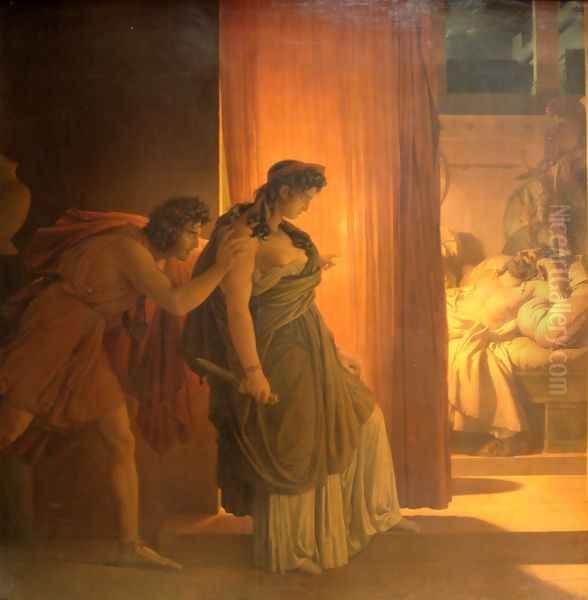
Pierre-Narcisse Guérin died in Rome on July 6, 1833, at the age of 59. He was buried in the church of Trinità dei Monti in Rome, alongside other illustrious French artists like Claude Lorrain.
Assessing Guérin's legacy requires acknowledging his dual role as a painter and a teacher. As a painter, he was a master of the Neoclassical style, yet his work often possessed a theatricality, an emotional depth, and a sensitivity to human drama that set him apart from the sterner classicism of David or the cool perfection of Jean-Auguste-Dominique Ingres. His paintings, particularly The Return of Marcus Sextus, resonated powerfully with contemporary audiences and demonstrated an ability to connect classical themes with current sensibilities.
However, his style was sometimes criticized, even during his lifetime and certainly by later generations, for lacking the profound originality or revolutionary fervor of either David or his own Romantic students. Some critics felt his work occasionally veered towards the melodramatic or that he adapted his themes and style too readily to prevailing tastes. Consequently, his reputation waned somewhat in the mid-19th century as Romanticism and then Realism came to dominate the art scene.
Yet, his importance as a transitional figure cannot be overstated. He bridged the gap between the Neoclassical world of his training and the Romantic world that his students would champion. Artists like Anne-Louis Girodet-Trioson, a student of David, also exhibited pre-Romantic tendencies, but Guérin's direct influence on Delacroix and Géricault gives him a special place in this transition.
His most significant and lasting impact may well have been through his teaching. By fostering a studio environment that, while academically rigorous, allowed for individual exploration, he played an undeniable role in the formation of the Romantic movement. The very fact that artists as distinct as Delacroix, Géricault, and Delaroche emerged from his tutelage is a testament to his pedagogical skills.
Guérin and His Contemporaries
Guérin operated within a vibrant and competitive artistic milieu. His relationship with Jacques-Louis David was one of respect for a master, but also of stylistic divergence. While David's art was often overtly political and characterized by a severe, almost austere classicism, Guérin's Neoclassicism was generally softer, more focused on personal drama and theatrical effect.
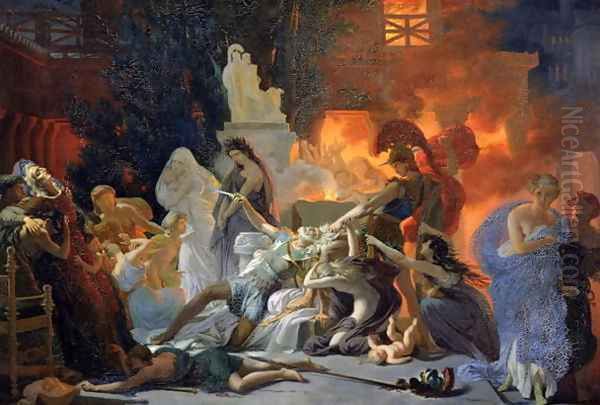
Compared to Jean-Auguste-Dominique Ingres, another towering figure of French Neoclassicism who was a student of David, Guérin's work appears less concerned with linear purity and idealized form, and more engaged with narrative and emotional expression. Ingres would become Delacroix's great rival, representing the enduring strength of the classical tradition against the onslaught of Romanticism.
Guérin's studio was a counterpoint to David's. While David also trained a generation of brilliant artists, including Ingres, Gros, and Gérard, Guérin's studio became the crucible for the next major artistic shift. Other contemporaries like Pierre-Paul Prud'hon also offered a gentler, more lyrical alternative to Davidian classicism, often incorporating a sfumato technique reminiscent of Correggio, and can also be seen as a transitional figure.
The artistic landscape of Paris during Guérin's career was dynamic. The Salons were battlegrounds for competing styles and reputations. The patronage of the state, whether under the Directory, the Consulate, the Empire, or the restored Bourbon Monarchy, heavily influenced the subjects and scale of artistic production. Guérin successfully navigated these changing tides, maintaining a prominent position throughout his career.
Conclusion: A Pivotal Contributor to French Art
Pierre-Narcisse Guérin was more than just a competent Neoclassical painter. He was an artist who captured the emotional tenor of his time in works like The Return of Marcus Sextus, and who consistently produced paintings of high technical skill and dramatic power. His subjects, drawn from the wellspring of classical literature and history, were imbued with a humanism and theatricality that appealed to a broad audience.
His role as an educator was profoundly important. By mentoring key figures of the Romantic movement, he inadvertently helped to usher in an era that would challenge many of the Neoclassical tenets he himself espoused. This makes him a fascinating and complex figure – a product of one tradition who became an important conduit for the next. While his name may not be as instantly recognizable today as David, Ingres, Géricault, or Delacroix, Pierre-Narcisse Guérin's contributions as both an artist and a teacher were vital to the evolution of French art in a period of profound transformation. His life and work offer valuable insights into the shifting artistic currents that defined the turn of the 19th century.